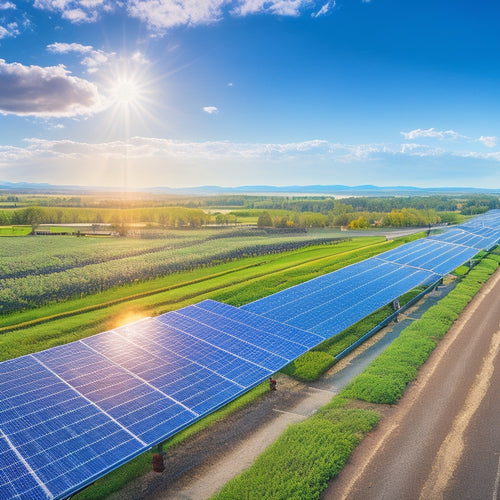
5 Tips to Slash Your Energy Bills
Share
You can greatly reduce your energy bills by implementing a combination of simple yet effective strategies that target the most energy-intensive aspects of your home. Conduct an energy audit to identify inefficiencies, then optimize your energy usage by utilizing natural light, upgrading to energy-efficient appliances, insulating and sealing air leaks, and investing in renewable energy sources. By tackling these areas, you'll be well on your way to slashing your energy bills. To unleash the full potential of these tips and take your energy savings to the next level, investigate each of these strategies in more detail to ascertain how they can benefit your home and wallet.
Overview
- Conduct an energy audit to identify inefficiencies and prioritize improvements to optimize energy usage effectively.
- Strategically place windows and skylights to maximize natural light and reduce reliance on artificial lighting.
- Replace outdated appliances with Energy Star-rated ones and integrate home batteries to store excess energy.
- Inspect and seal gaps and cracks in walls, floors, and ceilings to reduce energy waste and enhance home comfort.
- Consider investing in renewable energy sources like solar panels or wind turbines to generate electricity and reduce grid reliance.
Optimize Your Home's Energy Usage
Optimizing your home's energy usage starts with a thorough assessment of its energy efficiency. You can conduct an energy audit to identify areas of inefficiency and prioritize improvements. This assessment will help you determine the most effective ways to reduce energy consumption.
Consider calculating your total energy consumption in watt-hours (Wh) per day assess energy needs to get a better understanding of your energy usage. By reviewing past utility bills and analyzing energy-intensive appliances, you'll be able to optimize energy usage based on your findings.
Consider installing smart thermostats, which can learn your schedule and preferences to optimize heating and cooling. You'll be surprised at how much energy you can save by making a few simple changes.
Harness Power of Natural Light
During the day, sunlight pours into your home through windows, skylights, and glass doors, offering a free and abundant source of natural light.
By strategically placing windows and skylights, you can maximize the amount of natural light that enters your home, reducing the need for artificial lighting and energy consumption. This approach is also supported by Energy Efficient Smart Thermostats that optimize energy usage based on schedules and habits.
Additionally, consider using light colors on walls, floors, and furniture to reflect and amplify natural light. This won't only reduce energy consumption but also create a brighter, more welcoming atmosphere in your home.
Upgrade to Energy-Efficient Appliances
As you've successfully harnessed the power of natural light, it's time to turn your attention to another vital area that can greatly impact your energy bill: your appliances.
Outdated appliances can guzzle energy, increasing your bills and reducing your freedom. By integrating home batteries with your energy-efficient appliances, you can store excess energy for later and reduce your reliance on the grid.
Upgrading to energy-efficient models is an essential step towards slashing your energy costs, as they can optimize energy efficiency and contribute to Climate Action. Look for appliances with high Energy Star ratings, which indicate they meet energy efficiency standards set by the U.S. Environmental Protection Agency.
Not only will you reduce your energy consumption, but you'll also extend your appliance lifespan.
Insulate and Seal Air Leaks
Proper insulation and sealing air leaks are essential steps in reducing heat loss and heat gain, which can greatly impact your energy bill.
You can start by inspecting your attic insulation, ensuring it meets the recommended R-value for your region. Check for gaps and cracks in your walls, floors, and ceilings, and seal them with caulk or spray foam.
Don't forget to inspect your ducts, vents, and electrical outlets for air leaks, as these can be significant energy wasters.
Invest in Renewable Energy Sources
Frequently, homeowners overlook the significant impact that renewable energy sources can have on their energy bills. By investing in solar panel installation, you can utilize the power of the sun to generate electricity, reducing your reliance on the grid and slashing your bills.
Additionally, wind turbine benefits include a significant reduction in greenhouse gas emissions and a potential increase in your property value. With the cost of renewable energy systems decreasing over the years, it's now more feasible than ever to make the switch.
You can even sell excess energy back to the grid and earn credits towards your bill. By investing in renewable energy sources, you'll not only reduce your energy bills but also contribute to a cleaner, more sustainable future.
Frequently Asked Questions
How Do I Know if My Home Is Energy-Efficient Already?
You can determine if your home is energy-efficient by conducting an energy audit, which includes an insulation evaluation, to identify areas of heat loss and energy waste, and then prioritize improvements to maximize your energy independence.
Can Energy-Efficient Upgrades Increase My Home's Resale Value?
You're wondering if energy-efficient renovations will enhance your home's resale value? Absolutely, they will! According to studies, energy-efficient upgrades can increase your home resale value by up to 10%, making your property more attractive to potential buyers.
Are Energy-Efficient Appliances More Expensive to Purchase?
You'll find that 80% of consumers consider energy efficiency when buying appliances. While energy-efficient appliances may require a higher initial investment, they'll save you money in the long term with reduced energy consumption, ultimately giving you the freedom to allocate your budget as you choose.
Can I Get a Tax Credit for Energy-Efficient Home Improvements?
You can claim tax credits for energy-efficient home upgrades, but check tax credit eligibility first; research energy improvement incentives in your area, as federal and state governments offer varying rebates and credits for eco-friendly renovations.
Do Energy-Efficient Homes Require More Maintenance Than Others?
You'll be delighted to know that energy-efficient homes don't necessarily require more TLC; in fact, using high-quality, durable energy-efficient materials often means less frequent maintenance, giving you more freedom to focus on the things that matter most to you.
Ready to Buy
You've finally taken control of your energy consumption, and now you're reaping the benefits. Ironically, you're probably sitting in the dark, reveling in the glow of your lower energy bills. But don't get too comfortable - there's still more to be done. Keep optimizing, utilizing, upgrading, insulating, and investing. The environment (and your wallet) will thank you. As you bask in the savings, remember: a bright future is one that's energy-efficient.
Related Posts
-

Smart Home Thermostats to Revolutionize Your Space
Smart home thermostats revolutionize your space by providing precise temperature control and optimizing energy saving...
-
Average Lifespan of Solar Battery Banks
The average lifespan of solar battery banks generally ranges from 5 to 15 years. This variation mainly stems from the...
-

Applications of Photovoltaic Systems
Photovoltaic systems are versatile, converting sunlight into electricity for various applications. You can use them i...

